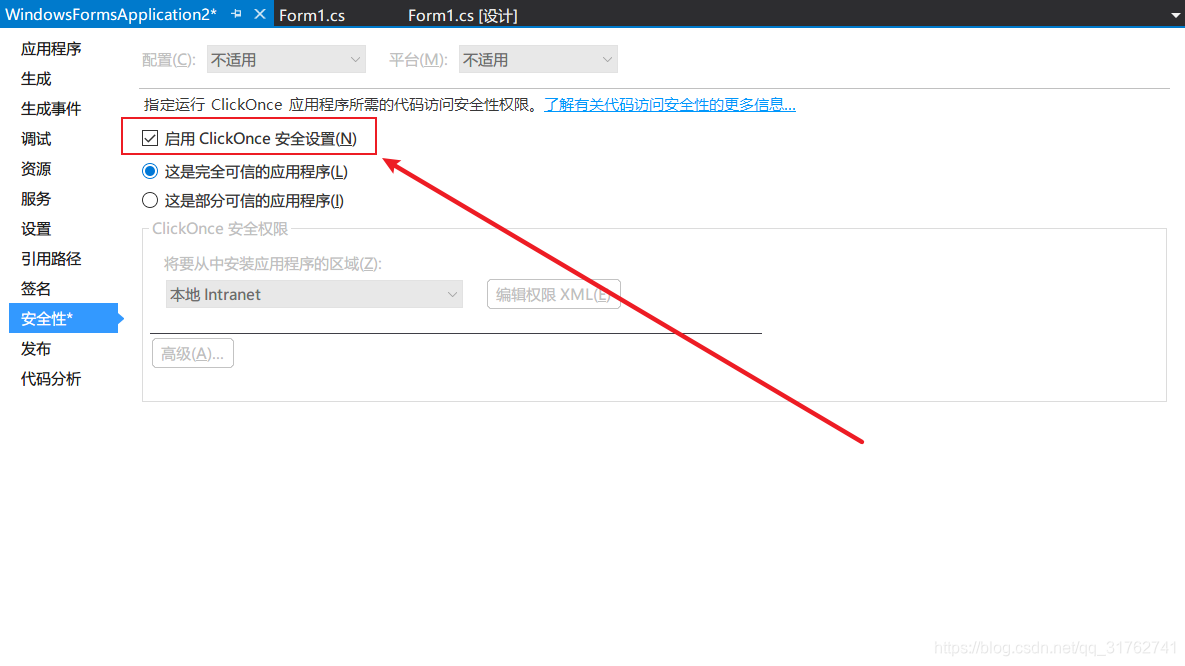C#如何以管理员身份运行程序
本文共 599 字,大约阅读时间需要 1 分钟。
在使用winform程序获取调用cmd命令提示符时,如果是win7以上的操作系统,会需要必须以管理员身份运行才会执行成功,否则无效果或提示错误。 比如在通过winform程序执行cmd命令时,某些情况下如果不是以管理员身份运行,则会提示命令无效。或者通过winform程序执行Windows Service 服务时,也需要以管理员身份才能调用Service服务。
下面讲解一下如何使程序获取管理员权限来运行。
- 在Visual Studio 中–解决方案资源管理器–右键项目名称–属性,找到“安全性”选项

- 勾选“启用ClickOnce安全设置”

- 这时,在项目下面会多出一个“app.manifest”的文件,选中它,并找到代码段
<requestedExecutionLevel level="asInvoker" uiAccess="false" />,将其改为:<requestedExecutionLevel level="requireAdministrator" uiAccess="false" />, 打开
打开 
- 改正后,不要急于重新编译生成,再次打开“属性–安全性”界面, 将“启用ClickOnce安全设置”前面的勾去掉后再编译运行。 不然程序会报错无法运行。

转载地址:http://onex.baihongyu.com/
你可能感兴趣的文章
mysql中floor函数的作用是什么?
查看>>
MySQL中group by 与 order by 一起使用排序问题
查看>>
mysql中having的用法
查看>>
MySQL中interactive_timeout和wait_timeout的区别
查看>>
mysql中int、bigint、smallint 和 tinyint的区别、char和varchar的区别详细介绍
查看>>
mysql中json_extract的使用方法
查看>>
mysql中json_extract的使用方法
查看>>
mysql中kill掉所有锁表的进程
查看>>
mysql中like % %模糊查询
查看>>
MySql中mvcc学习记录
查看>>
mysql中null和空字符串的区别与问题!
查看>>
MySQL中ON DUPLICATE KEY UPDATE的介绍与使用、批量更新、存在即更新不存在则插入
查看>>
MYSQL中TINYINT的取值范围
查看>>
MySQL中UPDATE语句的神奇技巧,让你操作数据库如虎添翼!
查看>>
Mysql中varchar类型数字排序不对踩坑记录
查看>>
MySQL中一条SQL语句到底是如何执行的呢?
查看>>
MySQL中你必须知道的10件事,1.5万字!
查看>>
MySQL中使用IN()查询到底走不走索引?
查看>>
Mysql中使用存储过程插入decimal和时间数据递增的模拟数据
查看>>
MySql中关于geometry类型的数据_空的时候如何插入处理_需用null_空字符串插入会报错_Cannot get geometry object from dat---MySql工作笔记003
查看>>